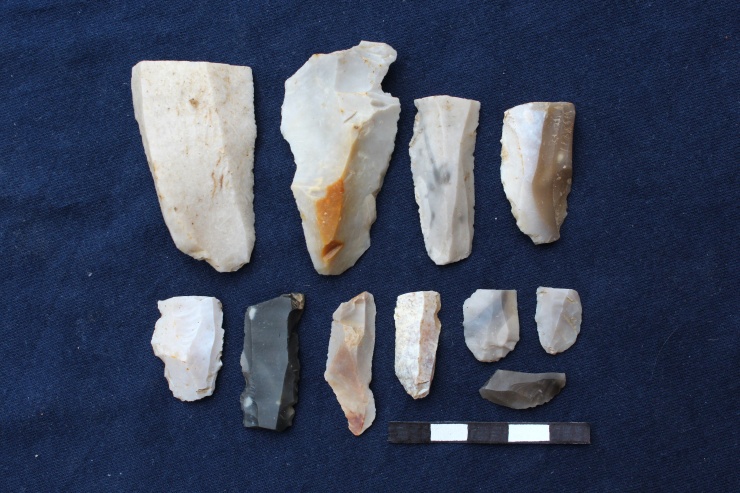Pěkný příspěvek.
Late Paleolithic hunter-gatherer stations Northernmost Bohemia is not archaeologically rich
Categories: Finds and rescue research in the Czech Republic
Northernmost Bohemia is not an archaeologically rich area. However, this is probably only the current state of knowledge, as the rugged landscape here seems to be full of hills and streams suited not only Mesolithic, but more recently Palaeolithic hunters from the very end of the last Ice Age.
Finding
I have been collecting chipped flint on a hill for some time. Typical tools to place the industry in time were missing for a long time, but according to finds from near and farther away, my friend and I placed it in the Mesolithic. However, the findings after the last ploughing made us uneasy. In a short strip of orange clay, where the plough had apparently gone deeper, several uncharacteristically largeand white-patinated spear points that don't belong in the classic Mesolithic inventory. So I decided to show them to the department, and with the exception of a few Mesolithic artifacts, the entire assemblage was dated to the Late Paleolithic. One piece even dates to the Middle Paleolithic. It's a fragment of a large, heavily eolianised flint blade with bilateral retouch. However, it was probably brought to the site later, probably as raw material for tool making. The question is from where, on the Czech side, the nearest Middle Palaeolithic site is only about 30km away, but only local flint-sunstones were used for production. On the German side the nearest similarly dated sites are about 100km away, in Poland even over 200km.
The whole set consists of 11 blades and their fragments, 9 cores and pieces of raw material, about 20 chips, 1 chisel and 1 drill. All made of flint, only one core, or rather piece of raw material is made of quartzite.
The site represents only the second confirmed surface site of this period in our district. Given the ploughed strip of pale clay with artefacts, it is suggested that there could still be a cultural layer somewhere deeper that could be probed or uncovered. A more precise cultural classification is problematic for the time being due to the constant lack of characteristic shapes, and the generally unclear distinction of the cultures of the time. However, other Late Palaeolithic surface finds in Saxony and north-west Bohemia tend to be assigned to the Federmesser group, widespread between 12 000-10 800 BC.
Characteristics of the period
The Late Palaeolithic is a very short period of about 2300 years at the end of the last glaciation, closing the long Pleistocene era. It is radiometrically dated between 11 950-9 640 BC, but its detailed subdivision is problematic due to rapid cultural changes and the lack or absence of stratigraphy.
Already at the end of the Magdalenian, less than 15,000 years ago, a fluctuating but definite warmingwhich, with the retreat of the glacier, allowed the settlement of the previously frozen areas of northern Europe. However, this climatic change was interrupted by global cooling in the form of the young Dryas 12 850-11 650 years ago. Its cause may have been the sudden spill of Canada's glacial Lake Agassiz into the Atlantic Ocean, and the subsequent disruption of the circulation of warm water from the equator to the North Pole, causing the return of tundra, particularly in NW Europe and Britain. But this event, lasting some 1200 years, did not, in effect, halt the overall upward trend in temperature.
As the climate improved there was a slow spread and incorporation of pine-birch stands, but the landscape was still open and scrubby. With the change in environment, there is also a retreat of cold-tolerant herd animals northwards or towards the mountainous areas where they could survive until the preboreal period. In its place, forest species such as deer, elk and bovids are taking their place. Megafauna such as the mammoth, the woolly rhinoceros and the cave bear are no longer found in Bohemia at this time.
The Late Palaeolithic ends 11,500 years ago with the onset of the Holocene and a rapid rise in temperatures of 5-10°C. The last hunter-gatherers and Mesolithic hunters live in the gradually forested landscape, continuing with minor changes in the Palaeolithic way of life. Innovations include the unique production of sharpened tools made from Jizera metabasite, the beginnings of crop cultivation and the deliberate burning of vegetation.
 Temperature evolution and the main European technocomplexes of the Late Palaeolithic
Temperature evolution and the main European technocomplexes of the Late Palaeolithic
 Part of the Middle Palaeolithic blade
Part of the Middle Palaeolithic blade
 Part of a Middle Palaeolithic flint blade-drawing
Part of a Middle Palaeolithic flint blade-drawing
 Blades and their parts
Blades and their parts
 Blades
Blades
 Dagger-drawing, the arrow marks the so-called "dagger strike
Dagger-drawing, the arrow marks the so-called "dagger strike
 Blades
Blades
 Drill
Drill

The article is included in categories:







